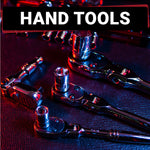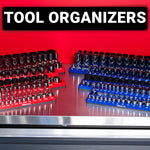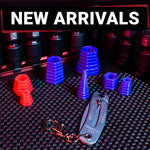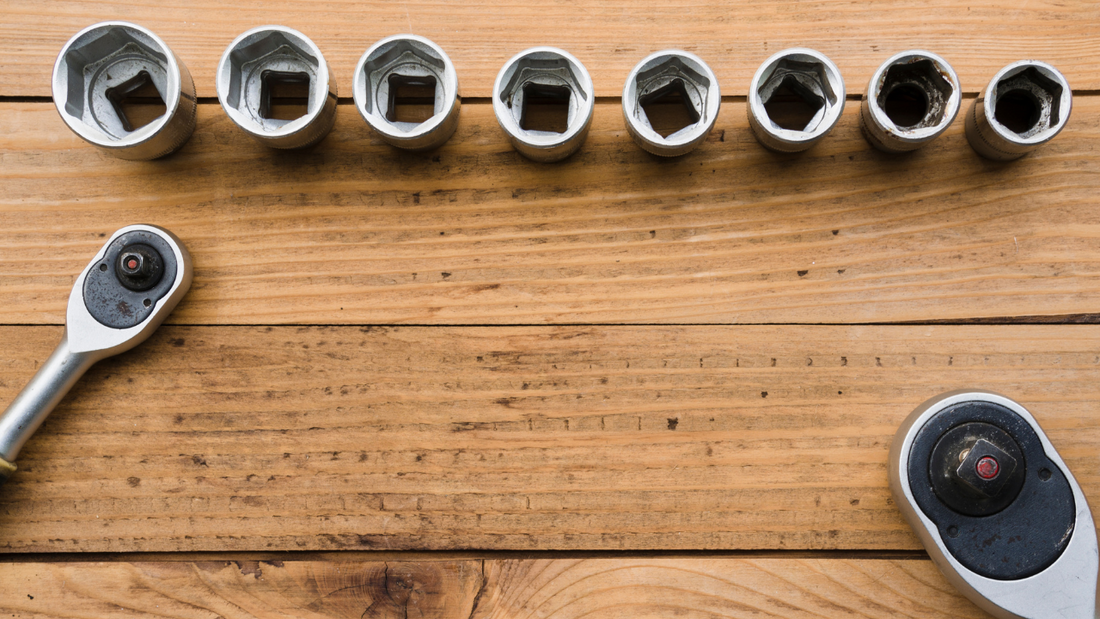A torque wrench lets you adjust fasteners to specific torque ratings. Whether you're rotating tires or rebuilding an engine, this tool protects sensitive components by preventing under-tightening, which can lead to parts falling off, or over-tightening, which can strip bolts or break components.
We’ll guide you through how to use a torque wrench, beginning with understanding the tool itself.
Shop our professional-grade torque wrenches.
Step 1: Understand Your Torque Wrench
A torque wrench applies exact force to nuts and bolts and gives you perfect tension every time. Professional mechanics use these torque tools for precise tightening that prevents stripped threads and broken fasteners; problems that lead to expensive repairs.
You'll find torque tools at work in auto shops, construction sites, and maintenance facilities where proper fastener tension keeps equipment running safely.
A standard torque wrench consists of several parts:
- A sturdy wrench handle with measurement markings
- A head with a ratchet mechanism for socket attachment
- An adjustment knob for setting torque values
- A mechanism that signals when you reach the set torque
Most automotive torque wrenches measure in foot-pounds (ft-lbs) or Newton-meters (Nm). These measurements tell you the rotational force needed for proper fastener tightness. For example, car wheel lug nuts typically require between 80 and 100 ft-lbs of torque.
Step 2: Find the Correct Torque Specifications
Start by determining the torque requirements for the fastener you’re working on. This can be found in equipment documentation, a car’s service manual, or a general bolt torque chart.
Note both the torque value and its unit of measurement (ft-lbs or N⋅m). Pay attention to any special instructions, such as torquing in a specific sequence or adding angle rotation after reaching initial torque.
Step 3: Prepare Your Torque Wrench
Make sure your torque wrench is at its lowest setting. Locate the adjustment mechanism at the bottom of the handle and unlock it. Rotate the handle until the measurement line aligns with your target torque value. Once aligned, lock the adjustment mechanism to prevent accidental changes during use.
Step 4: Clean and Inspect the Fastener
Dirty fasteners can throw off your torque wrench’s accuracy. Use a wire brush to remove rust, dirt, or debris from the bolt threads. Examine the threads for signs of damage or cross-threading that could affect your results. If your manufacturer specifies thread lubricant, apply it now.
The fastener's seating surface must also be clean and free of debris that could impact torque readings.
Step 5: Initial Fastener Installation
Threaten the bolt or nut by hand. This initial installation helps you feel if the fastener is properly aligned and turning smoothly without resistance.
A properly threaded fastener should turn easily until it becomes snug against the surface. If you feel any binding or unusual resistance, remove the fastener and check for problems.
Step 6: Attach the Correct Socket
Select sockets that match your fastener size. Verify that the socket's drive size matches your torque wrench and that it fully engages with the wrench's drive square.
Press the socket onto the wrench until you hear or feel it lock into place, then check that it seats over your fastener.
Step 7: Get the Right Grip
The arm of the wrench should have a grip or handle. For the most accurate torquing, the handle is where you should grip the wrench during operation. While negligible for most applications, gripping high or low on the arm alters the real force applied to the bolt compared to the measurement you receive.
Step 8: Apply Torque
Pull the handle with slow, smooth pressure. Avoid jerking motions or uneven force that could lead to incorrect readings. Keep the wrench perpendicular to the fastener throughout the motion.
As you apply pressure, pay attention to the distinctive click that indicates you've reached the set torque. Stop immediately when you hear or feel this click; continuing past this point can lead to over-tightening.
Step 9: Reset and Store the Wrench
After completing your work, always return the torque wrench to its lowest setting. This relieves spring tension and maintains the tool's calibration. Clean the wrench if necessary, and store it in its case or in a protected location where it won't be damaged.
For beam-type torque wrenches, the process changes slightly. These wrenches use an indicator beam instead of a click. The pointer moves across a scale as you apply pressure. Keep the wrench level and watch the pointer; stop when it reaches your target value.
How To Use a Torque Wrench on a Car
Your car contains a lot of fasteners that require specific torque. Here are some common fasteners that require accurate torquing.
Wheel Lug Nuts
Start by hand-tightening the lug nuts. Use a cross-pattern (star pattern) when tightening to prevent warped rotors. Begin with one lug nut, then move to the one opposite it. Continue this sequence until all nuts reach the proper torque.
Engine Components
Spark plugs require minimal torque. Overtightening strips threads in the aluminum heads. Most spark plugs need between 8-20 ft-lbs of torque.
Cylinder head bolts follow strict sequences. Your repair manual lists the pattern and torque stages. Many require multiple passes at increasing torque values.
Suspension Parts
Control arm bolts, strut mounts, and sway bar links need precise torque for proper suspension geometry. These specifications vary by vehicle manufacturer but typically range from 45–85 ft-lbs.
For most automotive applications, a click-type torque wrench is an excellent choice. The audible click prevents over-tightening in tight spaces where you can't see torque measurement gauges.
What Is the “20 Rule” for Torque Wrenches?
The 20% rule states torque wrenches measure most accurately between 20% and 100% of their maximum rating. A torque wrench rated for 100 ft-lb performs best between 20–100 ft-lb. This comes from how the internal spring mechanism reads force—springs need enough deflection for accurate measurements. Too little torque means unreliable readings.
For accurate fastener tightening, pick a torque wrench size where your target torque falls within this 20-100% window. A wrench rated at 25 ft-lb works from 5–25 ft-lb, a 50 ft-lb wrench from 10–50 ft-lb, and a 100 ft-lb wrench from 20–100 ft-lb. Using a wrench below 20% capacity can lead to inaccurate measurements and under-tightened fasteners.
Torque Wrench Usage Tips
A torque wrench gives perfect results only when used correctly. We’ve collected these tips from professional mechanics to help you protect your tools and guarantee accurate fastener tension:
- Start fasteners by hand.
- Clean threads before torquing (use a dry cloth and a wire brush).
- Inspect fastener threads for damage. Cross-threaded bolts require replacement.
- Apply smooth, steady pressure.
- Stop immediately when you hear the click (you reached the correct torque setting).
- Never use a torque wrench to loosen bolts. Use common ratchets or socket wrenches for loosening tasks.
- Return torque settings to zero after use.
- Pull the handle; never push.
- Keep the wrench at 90 degrees to the fastener.
- Store your wrench in its case.
- Annually recalibrate.
- Avoid using extension bars, as a handle extension changes the breakaway torque.
- Never exceed the maximum torque rating.
- Account for temperature; cold tools can give inaccurate readings.
When To Calibrate Your Torque Wrench
Regular calibration maintains your torque wrench accuracy. Most professional mechanics annually calibrate their torque wrenches. Calibration over time becomes more important with frequent use.
Besides annual calibration, you should recalibrate your torque wrench:
- After 5,000 cycles: For frequent use, most torque wrenches require calibration after 5,000 clicks or cycles.
- After dropping the wrench: A drop can throw off the internal mechanism.
- When torque accuracy feels off: If fasteners aren’t holding or readings seem inconsistent, it’s time for a check.
- After exposure to extreme conditions: High humidity, temperature changes, or dirt can impact performance.
Professional calibration services verify and adjust your torque wrench accuracy. They test multiple torque values and provide certification documents. This certification proves your wrench meets ISO or ASME standards for precision measurements.
How To Store Your Torque Wrench
Proper storage for wrenches protects your torque wrench and maintains its accuracy. The original storage case or a padded toolbox drawer protects against impacts and environmental damage. Before storage, reset the adjustment to zero to prevent internal spring fatigue that reduces accuracy. Torque wrenches left at high settings develop weakened springs and inaccurate readings.
Store in a dry environment at room temperature to prevent rust and corrosion and protect internal components. Lay the storage box horizontally since gravity can de-calibrate the wrench over time. Clean the wrench before storage; solvents will deteriorate seals and the surface finish.
Different Torque Wrench Types
There are several types of torque wrenches, each suited for different tasks and levels of precision:
- Click-style torque wrench: The most common type, it produces an audible "click" and a slight release of tension when the preset torque value is reached. Good for automotive work and general mechanical tasks.
- Beam torque wrench: Simple and reliable, this wrench uses a scale and a pointer to display the torque as you apply force. It doesn’t require calibration as often but requires careful monitoring to avoid over-torquing.
- Digital torque wrench: This advanced option provides a digital display of the torque value. It offers high accuracy and additional features such as alerts or memory storage. It’s great for professionals who need precise results.
- Dial torque wrench: Known for its accuracy, this wrench features a dial gauge that shows the applied torque in real time. It’s often used in quality control and important applications.
- Electronic torque wrench: Similar to digital wrenches, these tools include sensors that measure torque and often connect to software for data tracking. They’re typically used in specialized industries.
Each type of torque wrench offers unique benefits, but they all make sure fasteners are tightened accurately and safely.
Common Mistakes To Avoid
Since torque wrenches are sensitive tools, mishandling can damage them or damage your project. Here are some of the common mistakes you should avoid:
- Pushing instead of pulling: The torque wrench measures force accurately only when pulled in a steady arc. Pushing creates inconsistent readings and risks damage to the tool.
- Using the wrong size: A wrench used near its minimum or maximum torque range gives false readings. Select a wrench rated for your required torque range.
- Skipping thread preparation: Dirt and rust on threads change torque readings. Clean threads and proper lubrication create accurate, repeatable results. Every manufacturer specifies torque values based on clean, properly prepared fasteners.
- Continuing past the click: The click signals the correct torque. Additional force overtightens fasteners and damages parts. Stop when your wrench signals the correct setting.
- Missing calibration checks: An uncalibrated torque wrench produces unreliable results. Regular calibration testing confirms accuracy and catches problems before they cause fastener failures.
The last mistake you can make is using inferior tools. At Olsa Tools, we stand behind the quality and construction of our hand tools. Enjoy a limited lifetime warranty and a 90-day money-back guarantee when you choose an Olsa torque wrench. Are you ready to upgrade your toolbox?
Torque Wrenches FAQ
Do you hand tighten before using a torque wrench?
Yes. Thread fasteners by hand until they sit snugly against the surface. Hand tightening positions threads correctly and prevents cross-threading. The torque wrench then tightens from this stable starting point to achieve accurate final torque.
Can you overtighten with a torque wrench?
Yes, you can over-tighten if you continue applying force after the torque wrench clicks. Setting the wrong torque values, ignoring the click, or poor technique cause overtightening. Follow the torque specs and stop at the first click.
Are torque wrenches easy to use?
Ease of setup and ease of maintenance make torque wrenches a welcome addition to the toolboxes of novice DIYers and professional mechanics. Select the appropriate socket and adjust the wrench's torque value to the required setting to use the wrench. Then, reset it to the lowest setting and wipe it clean before storing it.
Should you double-click a torque wrench?
No, you shouldn’t double-click a torque wrench. The first click indicates the correct torque. Additional force after clicking over tightens the fastener.
Can you use regular sockets with a torque wrench?
Yes, you can use a regular socket with a torque wrench, provided they fit securely and are not subjected to excessive torque. While unnecessary, you can also use impact sockets with torque wrenches if that is what you have on hand. Impact sockets are rated for extreme force and can easily tolerate ft-lbs generated by torque wrenches.








